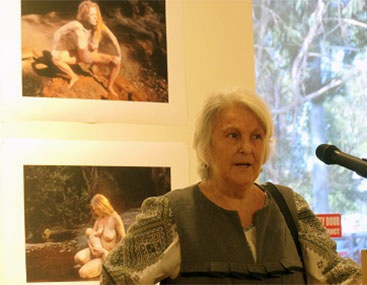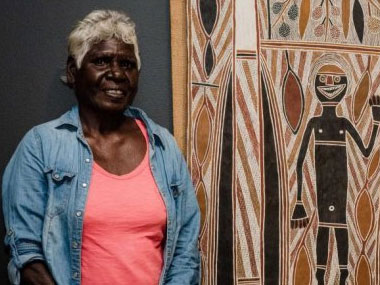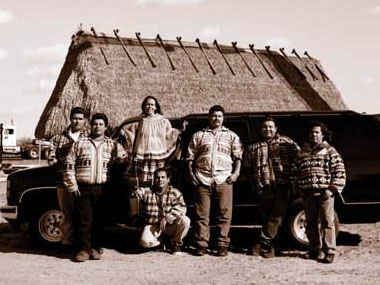INTERESTING TIMES

Juno Gemes at the opening of her Macquarie University Gallery exhibition, 'The Quiet Activist'
Posted by Jeremy Eccles | 13.05.19
Dates:
28.03.19
: 20.07.19
Every day I get a feed from Google telling me of every mention of Aboriginal art on the internet. Some days it's just a couple. Today there's Aboriginal art in Brisbane, Sydney, Canberra, Kalgoorlie, Forbes, Myrtleford, Darwin, Bendigo, Adelaide and London. I've previously suggested that it was all happening in America – but clearly, this country too is increasingly finding that it just can't manage without the everyday output of our most dynamic artists.
And that's even before the Archibald, Wynne and Sulman prizes were announced (see 'Who'll Win the Wynne in 2019).
OK – let's start in Bendigo at LaTrobe University where WA artist/curator Glenn Iseger-Pilkington is taking a suitably academic approach to the incredible variety of Aboriginal art today in a show called 'unbranded'. Emerging from ongoing discussions around the premise established by him in his essay 'Branded: the Indigenous Aesthetic' originally published in 2009, unbranded' challenges the relevance of an ‘Indigenous brand’ or ‘aesthetic’, and refutes the notion that such a brand can somehow represent the diversity of experience of Indigenous artists and Indigenous people across Australia.
He's accessed a range of artists from the top to bottom of Oz - Damien Shen, Dean Cross, Gunybi Ganambarr, Illiam Nargoodah, James Tylor, John Prince Siddon, Ngarralja Tommy May, Noŋgirrŋa Marawili, Nyurpaya Kaika Burton, Patrina Munuŋgurr, Sharyn Egan, Sonia Kurarra and Wukun Wanambi. Revealing an open mind to just what is 'Aboriginal art', Iseger-Pilkington has left out the most political and 'Western' of urban artists while seeking out 'traditional' artists pushing boundaries – such as Gunybi Ganambarr and Patrina Mununggurr. On until 22nd June.
Those Arnhemland artists are everywhere! Bula'bula weaving is currently at the Beaver Gallery in Canberra; and after a period of intense depression, Maningrida's artists are getting a brand new art centre designed (collaboratively of course) by the prestigious Hassell architects; and in Darwin at the University, the makarrata promised when gallery and museum directors from around the world gathered in Milingimbi has a second outing. For the local Yolngu art had disappeared from public viewing as artists died and other Arnhem art centres gained greater prominence – simply lost in storerooms. But those curators promised to give it new life.
'Reinvigorating the MECA Collection' of more than 200 bark paintings, weavings and carvings has come out of the Museum and Art Gallery of the NT storerooms with a mysterious history of having been illicitly sold out of the community. Artists like Binyinywuy disappeared from sight, and his descendants such as Judy Lirririnyin are now both delighted to see and feel their ancestry in the works, as well as raising the suggestion that they'd be better placed in a museum in Milingimbi.
The show continues into July.
Meanwhile, the WA State budget has found $20m for a Regional Arts and Culture Investment Program on top of $8 million for a Regional Exhibition Touring Boost and a $750,000 commitment to support regional museums and collections. Arts Minister David Templeman said: “One of the (funding) streams is the support in sustainability in our 30-plus Aboriginal arts centres throughout the State and this will be focused on creating and providing opportunity for Aboriginal artists to share their works broadly.”
In Sydney at the Macquarie University Gallery, the Hungarian-born photographer Juno Gemes gets a much-deserved retrospective. She lives on the Hawkesbury River and recent work captures the River's lazy essence, its oyster farmers and its mangroves, as well as giving it stories in a series called 'Fugitive Lovers' that leads up to her strong and confident heroine giving birth Aboriginal-style on an ochre rock platform. But Gemes is best known for her close and patient connection to The Movement, which has been at the forefront of the cultural and political struggle of Indigenous people in Australia. She has built a significant archive of images of events which include the struggle for land rights, the handing back of Uluru to its traditional owners and the national apology to the Stolen Generations in the federal Parliament.
Trust the outsider to get to the heart of this place. On until 28th June.
But it's insiders who are all-too-happy to replace commercial art dealers these days. Sydney's APY Collective Art Gallery has been a roaring success, with fresh exhibitions every couple of weeks. And with the 73-year-old Illuwanti Ken currently on show, it doesn't seem to be restricting itself to “young and emerging artists” as was the announced plan. And now Adelaide is getting a branch gallery – though Director Skye O'Meara did suggest that it was going to be more of a studio for APY artists when they have to be in Adelaide for health or other reasons. It's opening next Friday in a city where commercial Aboriginal art galleries have almost entirely disappeared.
Meanwhile, away in the UK, the august British Museum, housing eight million objects from around the world, much of it acquired under the British Empire, found itself involuntarily hosting a “Stolen Goods” tour featuring talks by Palestinian, Iraqi, Greek, and an Indigenous Australian activist. Around 300 people attended the tour which began in the so-called 'Enlightenment Room' – a permanent display which, in the words of the wall label, “uses thousands of objects to demonstrate how people in Britain understood their world” between 1680–1820. One of these objects is the Gweagal shield, acquired by Captain James Cook during an encounter with a group of locals at Botany Bay in 1770.
For the past three years Rodney Kelly, a Gweagal and Dharawal man himself from Bermagui, has been calling for the return of the shield, which he believes belonged to an ancestor, the warrior Cooman. He told the audience at the tour: “The shield tells the story of that first encounter in 1770. We had everything stolen — shields, spears. People need to know the real history of what happened”.
The shield was, in fact, in Australia at the National Museum quite recently (in 2015-16), and was returned to London. Now the Museum explains: “On Tuesday 30th April, Mr Kelly visited the Museum to see the shield and to meet with members of staff. It was a very positive visit, with suggestions for future collaborations to understand and interpret both the shield and other objects more fully. The Museum looks forward to continuing these discussions”.
URL: https://cdu.edu.au/artcollection-gallery/artgallery
Share this:
»  del.icio.us
»
del.icio.us
»  Digg it
»
Digg it
»  reddit
»
reddit
»  Google
»
Google
»  StumbleUpon
»
StumbleUpon
»  Technorati
»
Technorati
»  Facebook
Facebook
Contact Details

Judy Lirririnyin with her father, Binyinywuy's artwork 'Banubirr' (Morning Star story) at the Charles Darwin University exhibition, 'Reinvigorating the MECA Collection'

Fiona Foley's C-Type photograph, 'Wild times #2' (2001) which was selected for LaTrobe Uni's 'unbranded' exhibition in Bendigo
Further Research
Artists: Binyinywuy | Damien Shen | Dean Cross | Gunybi Ganambarr | Illiam Nargoodah | Illuwanti Ken | James Tylor | John Prince Siddon | Ngarralja Tommy May | Noŋgirrŋa Marawili | Nyurpaya Kaika Burton | Patrina Munuŋgurr | Sharyn Egan | Sonia Kurarra | Wukun Wanambi
News Tags: British Museum | Charles Darwin University | Glenn Iseger-Pilkington | Jeremy Eccles | June Gemes | LaTrobe University | Macquarie University | Milingimbi Makarrata
News Categories: Australia | Blog | Europe | Exhibition | Feature | Industry | News
Exhibition Archive
- 02.08.19 | Blak Douglas Wins the Kilgour
- 31.07.19 | Save the Date - Tarnanthi in October
- 22.07.19 | The McKenzie Powerhouse
- 20.06.19 | Large Scale Digital Art Exhibition
- 06.06.19 | FAIRS FAIRS
- 05.06.19 | NY is the Epicentre
- 30.05.19 | Namatjira Wins the Ramsey
- 20.05.19 | The Gagosian Effect
- 13.05.19 | INTERESTING TIMES
- 03.05.19 | GAGOSIAN OPENING TONIGHT
- 02.05.19 | WHO'LL WIN THE WYNNE IN 2019?
- 01.05.19 | Telstra NATSIAA finalists announced
- 14.04.19 | Gagosian Goes Aboriginal
- 10.04.19 | An Indigenous Biennale?
- 30.03.19 | Kunmanara Williams Stars at The National
Advertising

